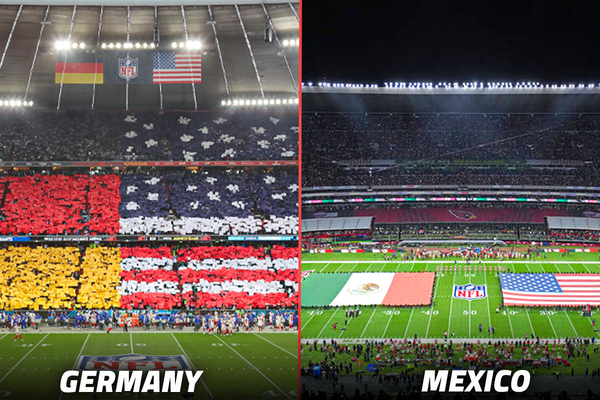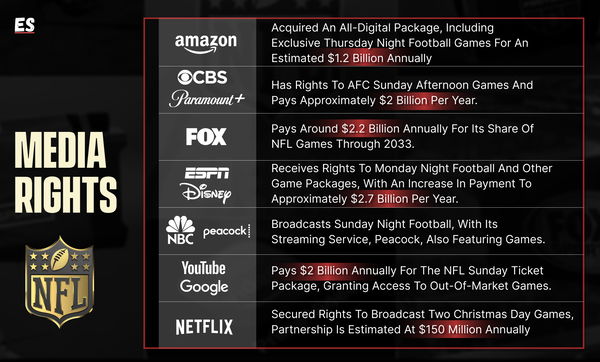
Imago
Credit: Imago

Imago
Credit: Imago
Back in December 2023, NFL owners made a bold move to expand the NFL International Series from the previous four to five games per season to up to eight starting in 2025. The reasoning was simple: if the NFL truly wanted to become a global phenomenon, limiting itself to just London and Germany wasn’t going to cut it. Sure, Mexico had its moment in 2016, and Brazil officially joined the international stage last season, but the league knew it was time to level up its global footprint.
Watch What’s Trending Now!
Fast forward to last year, and Commissioner Roger Goodell made it official and thrilling for fans worldwide. The 2025 season will feature seven international games, with Spain and Ireland stepping in as fresh hosts and a hope to return to Mexico City. “As we have previously mentioned, we are going to Spain, and we hope to return to Mexico City and Brazil,” Goodell said last year before the Panthers vs. Giants clash at Munich’s Allianz Arena.
“We will certainly be back in the United Kingdom. We are considering the possibility of playing in Ireland, and we will likely also return here to Germany.” But even though the optimism of making the NFL a global phenomenon is hard to ignore, and the NFL’s International Series expansion in 2025 signifies a bold step towards global growth, it raises pertinent questions about the balance between global ambitions and domestic fan interests. That’s where the conversation of “Will 2025 be the year the NFL goes truly international” begins.
ADVERTISEMENT
The growth of London, Germany & Mexico games
Incepted in 2007, the NFL International Series isn’t just about spreading football. It’s about building a global culture around the sport. Beyond the touchdowns and tackles, it fosters cultural exchange and puts American football on the world stage. Let’s break down the three main pillars of this international push: the NFL London Games in the U.K., the NFL Germany Games, and the NFL Mexico Games, beginning with London:
What began as a bold experiment to gauge international interest has now grown into an annual series of sold-out spectacles, captivating fans across the globe and cementing the NFL’s presence on the world stage. The echoes of the Giants beating the Dolphins at Wembley are still fresh. Ever since, attendance figures have consistently hovered between 80,000 and 85,000 fans at Wembley.
ADVERTISEMENT

Imago
Credit: Imago
Besides, at the heart of the NFL London Games is the Tottenham Hotspur Stadium, which is designated as the “Home of the NFL” in the UK. A couple of years back, this state-of-the-art venue was confirmed to host at least two regular-season games annually through 2029. Designated with NFL locker rooms, it hosted its first game back in 2019, and since then, tickets for an NFL fixture sell out within minutes.
ADVERTISEMENT
To provide context, Pro Football Network reports that central London hotels experience occupancy rates reaching 95% during NFL weekends. Additionally, each game generates approximately £40 million for the local economy through tourism revenue, stadium operations, and broadcast partnerships—demonstrating that football’s impact extends well beyond the field to create substantial economic benefits. However, London is not the sole European market involved in this expansion.
Top Stories
Forced to Leave FOX, Cowboys Legend Troy Aikman Says ESPN Is Like ‘U.S. Government’ & Clearly Distinguishes the Two Networks

FOX Issues Strict Ban on Terry Bradshaw But NFL Legend Defies It to Join Popular Morning Show

What Happened to T.J. Watt? Why Is He Hospitalized? Steelers Announce Latest News on LB Before Dolphins Game

T.J. Watt Health Update: NFL Doctor Provides Analysis on Steelers LB Following Hospitalization

Cam Newton Reveals Exactly Why 32 NFL Teams Blacklisted Him as Panthers Legend Announces Retirement Status

NFL makes history in Munich. That was the headline the week when the Buccaneers took down the Seahawks in the NFL’s first regular-season game hosted in Germany. The league reported 69,811 fans attended the sold-out game live in the Allianz Arena. Yes, it’s the home to Bundesliga side FC Bayern Munich. On top of that, the game became the NFL Network’s most-watched international broadcast, drawing in over 5.8 million viewers.
Across the pond, German broadcaster ProSieben pulled in 2.7 million viewers for the Buccaneers’ 21-16 win. And the buzz didn’t stop at the screen—merchandise sales at Allianz Arena hit the highest levels ever recorded for an NFL game outside the U.S., proving the global appetite for football is very real. “Munich will forever be a part of NFL history, in what was a significant milestone in the continued growth of the League globally and for our fans in Germany,” Goodell said.
ADVERTISEMENT

Imago
Credit: Imago
Last but not least, Mexico—just a stone’s throw from the U.S.—has never lagged in drawing the fans. When it comes to the NFL’s international fanbase, Mexico clearly takes the crown. Estimates put the number at over 46 million fans, making it the biggest pool of NFL supporters outside the US. Take the NFL’s return to Mexico City in 2022, for instance. The Raiders vs. Texans showdown generated an estimated $45 million in economic impact on Mexico City.
The obstacles facing NFL game hosting in Mexico this year are evident due to ongoing renovations at Estadio Azteca. However, one factor remains indisputable: NFL games deliver substantial economic benefits to Mexico City. When considering the NFL International Series comprehensively, it has generated approximately $200 million annually by 2024. Yet achieving true global reach extends beyond venues and infrastructure. For the NFL to connect with international audiences, streaming and broadcasting capabilities are equally critical, ensuring that the International Series excitement reaches fans well beyond the geographical boundaries of host cities.
ADVERTISEMENT
New media rights & streaming: The upsides and the downsides
In 2022, the NFL reached a seven-year deal worth about $2 billion annually with Google, ending DirecTV’s nearly 30-year hold on Sunday Ticket and giving YouTube TV and YouTube Primetime Channels exclusive rights to the out-of-market package starting in 2023; fans were able to buy it either as an add-on to YouTube TV or as a standalone option on Primetime Channels after Apple, once viewed as the frontrunner, withdrew from talks weeks before the agreement.
So this year, fans will be able to exclusively stream the Chiefs vs. Chargers international game in Brazil on YouTube. It won’t be wrong to say that multiple streaming and broadcasting services provide the NFL a stage to present the NFL on a global level.
ADVERTISEMENT
However, this also raises a pertinent question: Does the proliferation of multiple streaming platforms genuinely serve international audiences, or does it create additional complications for domestic viewers? To illustrate the complexity, accessing complete NFL coverage requires subscriptions to Amazon Prime, Netflix, Peacock, and YouTube, alongside ESPN (via streaming or cable), YouTube TV with NFL Sunday Ticket or NFL+, Paramount+ (CBS’s streaming platform), and the emerging Fox One streaming service. This totals nine streaming services for a five-month season upon closer examination.

ADVERTISEMENT
As for the international fanbase, all 2025 NFL International Games will be available through NFL Game Pass, powered by DAZN, in markets outside the U.S., and for the local broadcasters:
- Germany: RTL will broadcast NFL games, including international matchups.
- United Kingdom: Sky Sports holds broadcasting rights for NFL games.
ADVERTISEMENT
This fragmentation has led to concerns about rising costs for fans who previously had more centralized access through traditional cable packages. A MarketWatch article highlights that the average U.S. household currently spends $69 a month on four streaming services. Roger Goodell believes that these games on streaming platforms are value-adds for fans not just across the country but the world as well, which didn’t exist before.
Long story short: the new media rights & streaming expansion deals in two different ways. On one hand, as Goodell puts it, this is the NFL serving the next generation of NFL fans. The logic tracks as well: the majority of the audience for streaming platforms (like YouTube TV, Peacock, or Amazon Prime Video) tends to be in younger age groups. But on the other hand, it also introduces complexities and costs for NFL fans.
How does the NFL International Series affect the teams and fans?
The NFL will kick off the 2025 season with seven international games scheduled on its calendar. The scheduled games are as follows:
- Chiefs vs Chargers: São Paulo, Brazil, September 4
- Steelers vs Vikings: Dublin, Ireland, September 28
- Vikings vs Browns: London, U.K., October 5
- Broncos vs Jets: London, U.K., October 12
- Rams vs Jaguars: London, U.K., October 19
- Falcons vs Colts: Berlin, Germany, November 9
- Dolphins vs Commanders: Madrid, Spain, November 16
Looking at this, one question emerges: How will it affect the team and the players? Back in 2023, the then-head coach of the Jaguars, Doug Pederson, led his team to a couple of international wins in London. But the frustration was visible after a two-week stay in the United Kingdom. “The jet lag is real,” Pederson told the reporters. “Just spend(ing) more time with walkthroughs, slow(ing) the pace down a little bit. Try to get their bodies and minds rejuvenated again. I can do my part by helping get them off the field to continue their rehab and treatments. It is individual how each person handles it.”
On top of that, Pete Carroll, when he was still the HC of the Seahawks, pointed out one issue in Munich. In 2022, the Seahawks faced the Bucs in Germany, and the players had a difficult time keeping their footing during the game. Caroll called the playing surface “a nightmare.” Long story short, it’s safe to say that the NFL International Series has its own pros and cons.
While the NFL’s international odyssey unfolds with each passing season, casting its spell across distant shores, the journey toward true global dominion remains an ambitious quest with many chapters yet to be written.
ADVERTISEMENT
ADVERTISEMENT
ADVERTISEMENT

